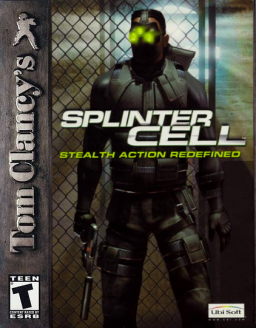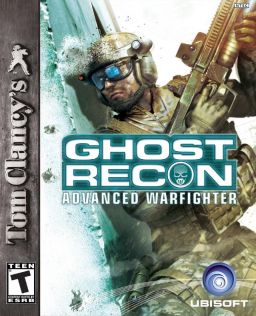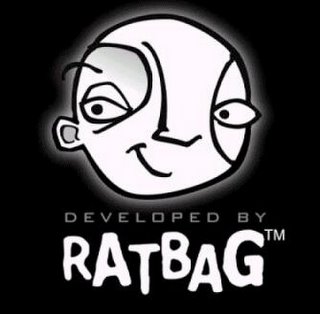
Tom Clancy's Splinter Cell is a 2002 stealth game developed by Ubi Soft Montreal and published by Ubi Soft. It is the first game in the Splinter Cell series. Endorsed by author Tom Clancy, it follows the activities of NSA black ops agent Sam Fisher. The game was inspired by both the Metal Gear series and games created by Looking Glass Studios, and was built using Unreal Engine 2.

Tom Clancy's Rainbow Six 3: Raven Shield is a 2003 tactical first-person shooter video game developed by Red Storm Entertainment and published by Ubi Soft for Microsoft Windows and Mac OS X. It is the third entry in the Rainbow Six series. The game's plot follows Rainbow, a secret international counterterrorist organization, as they respond to a wave of terrorist attacks threatening South America.

Driver is a video game series developed by Reflections Interactive, and originally published by GT Interactive, later by Infogrames/Atari and now by Ubisoft. The gameplay consists of a mixture of action-adventure and driving in open world environments. Since the series began in 1999, there have been five main installments released.

Tom Clancy's Splinter Cell: Pandora Tomorrow is a 2004 stealth game developed and published by Ubisoft Shanghai and Ubisoft Milan. The game is the sequel to Splinter Cell and the second game in the Splinter Cell series endorsed by writer Tom Clancy. It follows the covert activities of Sam Fisher, an agent working for a black-ops branch of the National Security Agency (NSA) called "Third Echelon". Michael Ironside returns to voice Sam Fisher, while Dennis Haysbert voices the character Irving Lambert, Fisher's boss, making this the only time he is not voiced by Don Jordan. Lalo Schifrin provides the theme music for the game.

Tom Clancy's Ghost Recon Advanced Warfighter (GRAW) is a tactical shooter video game released for the Xbox 360, Xbox, PlayStation 2 and Microsoft Windows in 2006. As in previous Ghost Recon games, players command their team while neutralizing hostile forces and completing various mission objectives. These objectives can range from escorting friendly units across the map to rescuing hostages or taking out enemy artillery.

Street Racing Syndicate is an open world multiplatform racing video game produced by Eutechnyx, and released by Namco on August 31, 2004, for the PlayStation 2, GameCube, Xbox and Windows-based personal computers. The game was also released for the Game Boy Advance on October 4, 2005. During its release, it was meant to compete against Need for Speed: Underground 2, the sequel to the critically acclaimed first game released in 2003.

Rocky is a fighting video game published by Rage Software and released in 2002. The game is based on the Rocky franchise.
Far Cry is an anthology franchise of first-person shooter games, all of which have been published by Ubisoft. The first game, Far Cry, was developed by Crytek to premiere their CryEngine software, and released in March 2004. Subsequently, Ubisoft obtained the rights to the franchise and the bulk of the development is handled by Ubisoft Montreal with assistance from other Ubisoft satellite studios. The following games in the series have used a Ubisoft-modified version of the CryEngine, the Dunia Engine, allowing for open world gameplay. In the present, the franchise consists of six mainline games, a standalone expansion, and several spin-offs; additionally, the first game, initially developed for Microsoft Windows, saw a number of ports to video game consoles, which changed several elements and are therefore considered standalone releases.

Ratbag Games Pty Ltd was an Australian developer of video games such as Powerslide, The Dukes of Hazzard: Return of the General Lee and World of Outlaws: Sprint Cars 2002.
Brothers in Arms is a tactical shooter video game series by Gearbox Software, consisting of ten individual games. The core series consists of the first-person shooters Brothers in Arms: Road to Hill 30 (2005), Brothers in Arms: Earned in Blood (2005), and Brothers in Arms: Hell's Highway (2008). The storyline is set against the backdrop of the liberation of Western Europe during World War II. It has mainly been released for Windows and MacOS platforms as well as sixth and seventh generation consoles and some mobile devices.

Assassin's Creed is a historical action-adventure video game series and media franchise published by Ubisoft and developed mainly by its studio Ubisoft Montreal using the game engine Anvil and its more advanced derivatives. Created by Patrice Désilets, Jade Raymond, and Corey May, the Assassin's Creed video game series depicts a fictional millennia-old struggle between the Order of Assassins, who fight for peace and free will, and the Knights Templar, who desire peace through order and control. The series features historical fiction, science fiction, and fictional characters intertwined with real-world historical events and historical figures. In most games, players control a historical Assassin while also playing as an Assassin Initiate or someone caught in the Assassin–Templar conflict in the present-day framing story. Considered a spiritual successor to the Prince of Persia series, Assassin's Creed took inspiration from the novel Alamut by the Slovenian writer Vladimir Bartol, based on the historical Hashashin sect of the medieval Middle East.

The Dukes of Hazzard: Racing for Home is a racing video game published by SouthPeak Interactive that was released for the PlayStation in 1999. The game was later released for Game Boy Color and Microsoft Windows in 2000. It is based on the television show, The Dukes of Hazzard. Waylon Jennings, James Best, Ben Jones, Sonny Shroyer, and Tom Wopat reprised their characters by providing their voices to the PC and PlayStation versions of the game. A sequel titled The Dukes of Hazzard II: Daisy Dukes It Out was released in 2000.

Rayman Legends is a platform video game developed by Ubisoft Montpellier and published by Ubisoft. It is the fifth main title in the Rayman series and the direct sequel to the 2011 game Rayman Origins. The game was released for Microsoft Windows, PlayStation 3, Xbox 360, Wii U, and PlayStation Vita platforms in August and September 2013. PlayStation 4 and Xbox One versions were released in February 2014, with a Stadia version released in November 2021. A Nintendo Switch port, titled Rayman Legends Definitive Edition, was released in North America, Europe and Australia on September 12, 2017.
Just Dance is a rhythm game series developed and published by Ubisoft. The original Just Dance game was released on the Wii in 2009 in North America, Europe, and Australia.

Rocksmith 2014 is a music video game produced by Ubisoft. It is a followup to the 2011 game Rocksmith, but has been described as a replacement to the original game rather than a sequel. Like its predecessor, the game allows players to plug in virtually any electric guitar or bass guitar and play along via the use of a USB adapter – removing the need for any proprietary controller like other music games such as Guitar Hero. The game comes with 66 songs on disk, with over a thousand more available to download as paid DLC. It was announced at Ubisoft's 2013 E3 presentation and was released for PlayStation 3, Xbox 360 and PC/Mac in October 2013, with versions for PlayStation 4 and Xbox One releasing in November 2014.

The Crew is a 2014 online-only racing video game co-developed by Ubisoft Ivory Tower and Ubisoft Reflections and published by Ubisoft. The game was released for PlayStation 4, Windows, and Xbox One, with an Xbox 360 port developed by Asobo Studio in December 2014, and for Amazon Luna in November 2020. It features a persistent open world environment for free-roaming across a scaled-down recreation of the Contiguous United States and included both role-playing and large-scale multiplayer elements.

Child of Light is a platforming role-playing video game developed by Ubisoft Montreal and published by Ubisoft for Windows, PlayStation 3, PlayStation 4, Wii U, Xbox 360 and Xbox One in April 2014, and was released on PlayStation Vita in July 2014. The game was later released on Nintendo Switch on 11 October 2018; the announcement of this release also teased a sequel. Versions for Amazon Luna and Google Stadia were released in August and October 2021, respectively. The game is powered by UbiArt Framework.

Just Dance 2015 is a 2014 dance video game developed and published by Ubisoft. The sixth main installment of the Just Dance series, it was announced at Ubisoft's E3 2014 press event on 9 June 2014 alongside Just Dance Now—a web-based spin-off of the franchise. It was released for PlayStation 3, PlayStation 4, Xbox 360, Xbox One, Wii, and Wii U on 21 October 2014 in North America, 23 October in Europe, 24 October in the UK and 25 October in Asia.

Tetris Ultimate is a puzzle video game developed by American studio SoMa Play and published by Ubisoft. Ubisoft partnered with The Tetris Company to develop the game to celebrate the 30th anniversary of the Tetris franchise.
Watch Dogs is an action-adventure video game franchise published by Ubisoft, and developed primarily by its Montreal and Toronto studios using the Disrupt game engine. The series' eponymous first title was released in 2014, and it has featured three games in total, the most recent being 2020's Watch Dogs: Legion. Several tie-in books and comic book miniseries set in the games' universe have also been published.
















